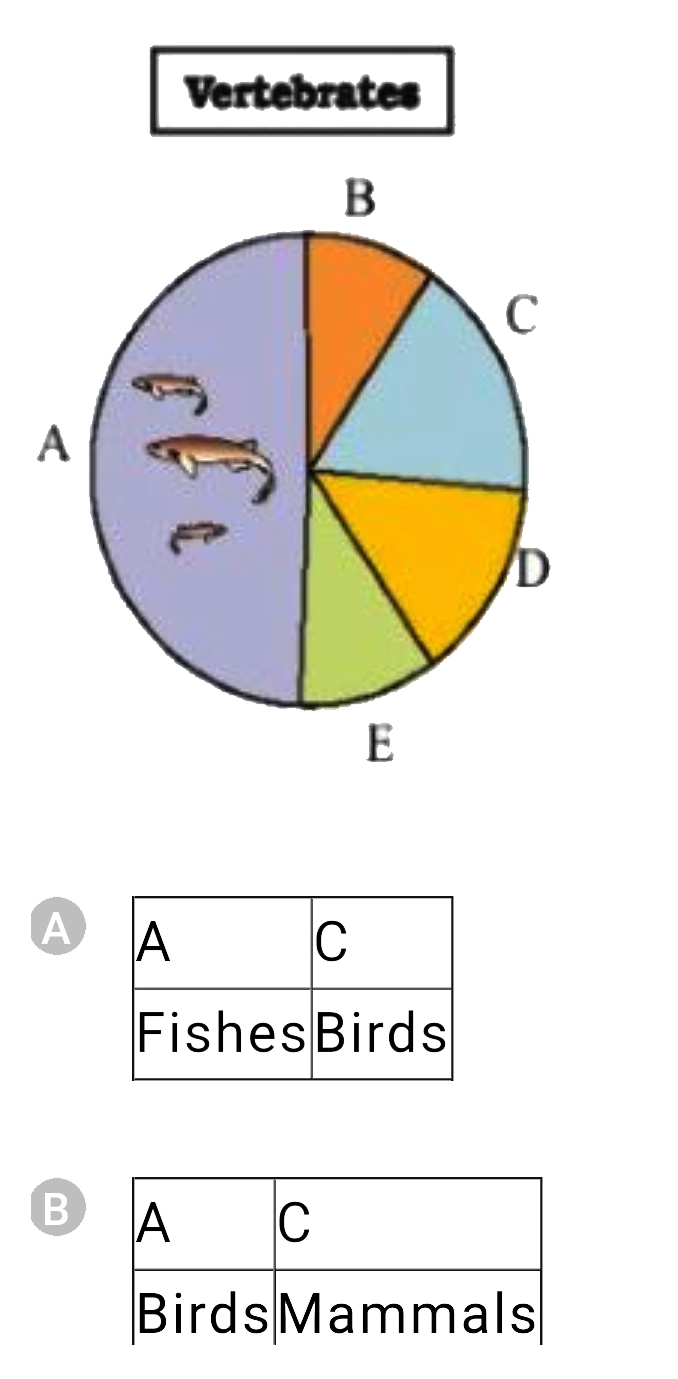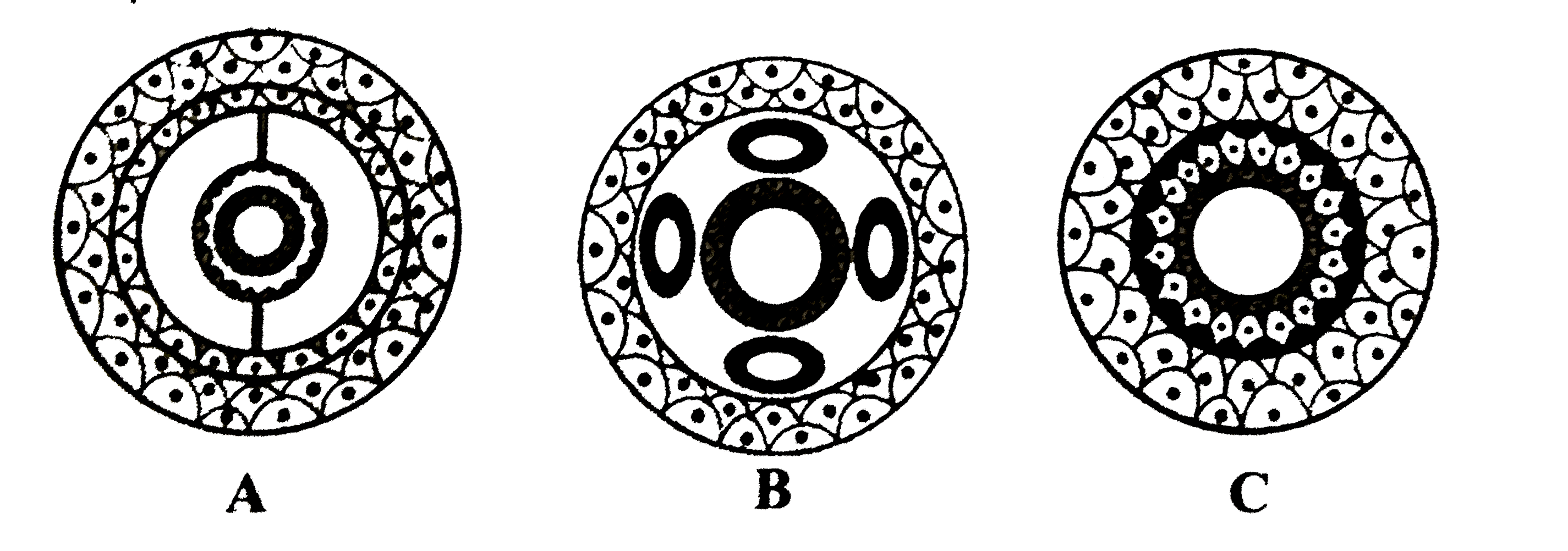Riya grouped plants broadly on the basis of type of venation present in their leaves. In one of the groups she placed an incorrect member by mistake. Identify this group and select the correct option.
Petunia, Hibiscus, Rose
Maize, Palm, Peepal
Grass, Wheat, Banana
Basil, Neem, Mango
The correct Answer is:B
To solve the question regarding Riya's grouping of plants based on the type of venation in their leaves, we will follow these steps:
Step 1: Understand the Types of Venation
- Venation refers to the arrangement of veins in a leaf.
- There are two main types of venation:
- Reticulate Venation: This is characterized by a network of veins, commonly found in dicot plants.
- Parallel Venation: This features veins that run parallel to each other, typically found in monocot plants.
Step 2: Identify the Plants in the Options
- We need to analyze the plants mentioned in the options to determine their type of venation.
- Common plants and their venation types:
- Reticulate Venation: Rose, Neem, Basil, Petunia
- Parallel Venation: Maize, Wheat, Banana, Palm, Grass
Step 3: Analyze the Grouping
- Riya has grouped plants based on their venation.
- We need to identify if there is an incorrect member in her grouping.
Step 4: Check Each Option
- Let's check the options provided:
- If one of the plants listed under reticulate venation is actually a parallel venation plant, that would be the incorrect member.
- For example, if "Pipel" (which is actually "Pipal" or "Peepal") is listed under reticulate but is a parallel venation plant, that would be incorrect.
Step 5: Identify the Incorrect Member
- Based on the analysis, if "Pipel" is incorrectly placed in the reticulate group, then it should be noted that it is actually a plant with reticulate venation.
- Therefore, the incorrect member is likely from the group of plants that are supposed to have parallel venation.
Conclusion
- The incorrect member placed by Riya is "Pipel," as it belongs to the reticulate venation group.
- The correct option to select would be the one that indicates "Pipel" is incorrectly grouped.
Final Answer
- The incorrect member is "Pipel," and it should be placed in the reticulate venation group.
- Venation refers to the arrangement of veins in a leaf.
- There are two main types of venation:
- Reticulate Venation: This is characterized by a network of veins, commonly found in dicot plants.
- Parallel Venation: This features veins that run parallel to each other, typically found in monocot plants.
- We need to analyze the plants mentioned in the options to determine their type of venation.
- Common plants and their venation types:
- Reticulate Venation: Rose, Neem, Basil, Petunia
- Parallel Venation: Maize, Wheat, Banana, Palm, Grass
- Riya has grouped plants based on their venation.
- We need to identify if there is an incorrect member in her grouping.
- Let's check the options provided:
- If one of the plants listed under reticulate venation is actually a parallel venation plant, that would be the incorrect member.
- For example, if "Pipel" (which is actually "Pipal" or "Peepal") is listed under reticulate but is a parallel venation plant, that would be incorrect.
- Based on the analysis, if "Pipel" is incorrectly placed in the reticulate group, then it should be noted that it is actually a plant with reticulate venation.
- Therefore, the incorrect member is likely from the group of plants that are supposed to have parallel venation.
- The incorrect member placed by Riya is "Pipel," as it belongs to the reticulate venation group.
- The correct option to select would be the one that indicates "Pipel" is incorrectly grouped.
- The incorrect member is "Pipel," and it should be placed in the reticulate venation group.
Topper's Solved these Questions
- BOOK - SCIENCE OLYMPIAD FOUNDATION CHAPTER - NSO QUESTION PAPER 2017-18 SET AEXERCISE - ACHIEVERS SECTION3videos
NSO QUESTION PAPER 2017-18 SET A
- BOOK - SCIENCE OLYMPIAD FOUNDATION CHAPTER - NSO MODEL TEST PAPER 02EXERCISE - ACHIEVERS SECTION1videos
NSO MODEL TEST PAPER 02
- BOOK - SCIENCE OLYMPIAD FOUNDATION CHAPTER - NSO QUESTION PAPER 2017-18 SET BEXERCISE - ACHIEVERS SECTION2videos
NSO QUESTION PAPER 2017-18 SET B
Similar Questions
Knowledge Check
- Question 1 - Select One
Vessels are present in which one of the following groups of plants ?
ABryophytaBPteridophytaCGymnospermsDAngiosperms - Question 2 - Select One
A and C are vertebrate groups having a varied number of species globally . Select the correct option.
 AACFishesBirdsBACBirdsMammalsCACReptilesBirdsDACFishesMammals
AACFishesBirdsBACBirdsMammalsCACReptilesBirdsDACFishesMammals - Question 3 - Select One
Consider the following statements
I.The-OH group present in the phenol is ortho and para directing
II.Directive influence of a functional group in monosubstituted benzene depends on the nature of the substituent already present in the benzene ring.
III.The -OH group activates the benzene ring for the attack by an electrophile
Select the correct option.AI and IIBII and IIICII,III,IVDAll of the above
Select one of the following sets in which there are three members of group 2
View SolutionMatch the following group of organisms with their respective distinctive characteristics and select the correct option:
 View Solution
View SolutionMatch the following group of organisms with their respective distinctive characteristics and select the correct option:
 View Solution
View SolutionThe figures given below show the types of coelom. Identify them and select the correct group of organisms which possess them.
 View Solution
View SolutionConsider the following statements:
(A) Coenzyme or metal ion that is tightly bound to enzyme protein is called prosthetic group,
(B) A complete catalytic active cnzyme with its bound prosthetic group is called apoenzyme. Select the correct optionView Solution


